For all my U.S. friends it could be interesting to see the differences between an average IFR flight in the U.S. and in Europe.
Today we made a flight from Bern (LSZB) in Switzerland no Cannes (LFMD) at the French Riviera. We had terrible weather the last 36 hours in Switzerland with a lot of rain, low temperatures and even snow down to 5’200 ft. A high trough with his axis above the Alps was responsible for this weather with high reaching cold air.
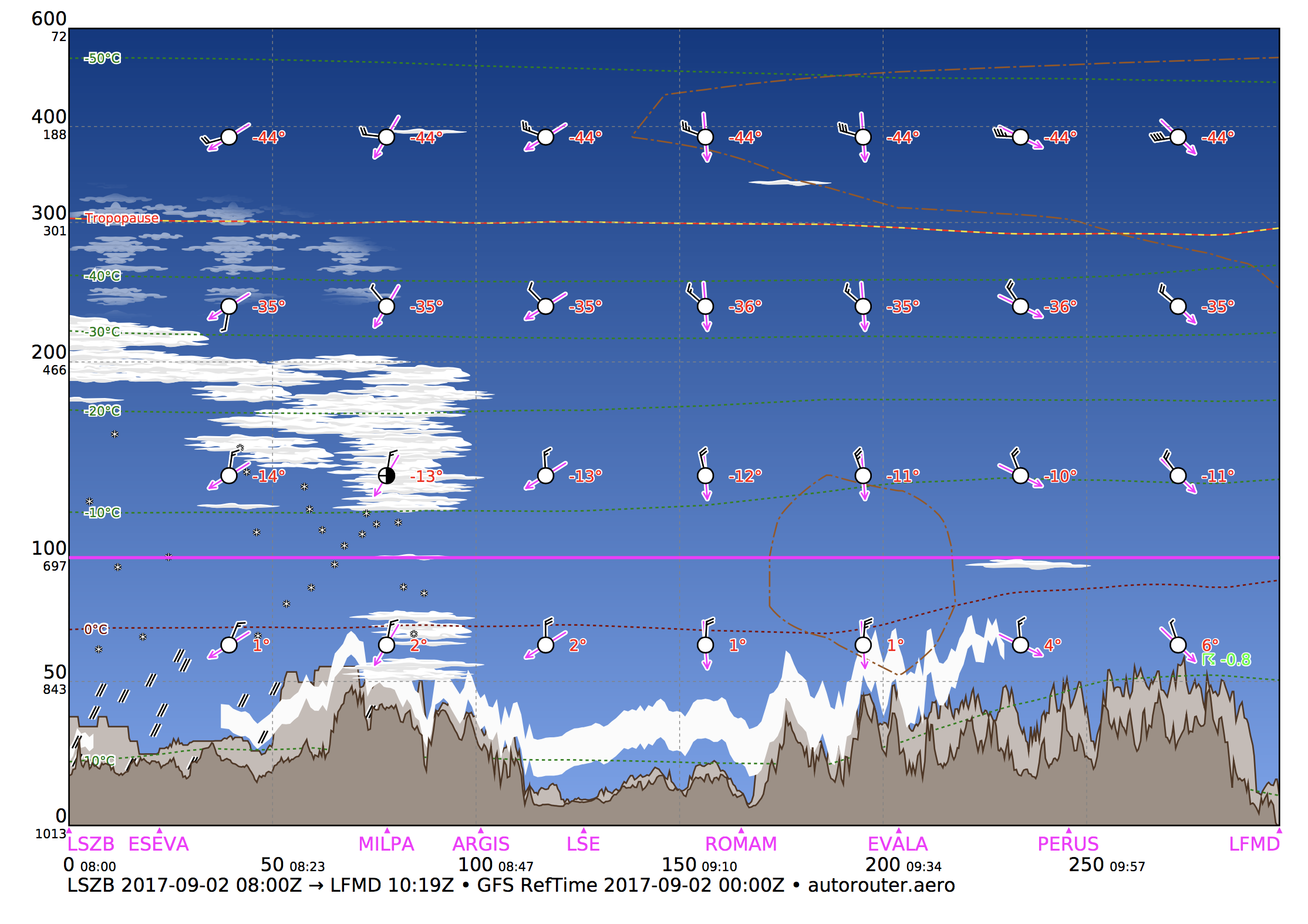

That’s what the Jeppesen App said about icing.
While planning the flight and checking the GRAMET, I filed for FL 090. GRAMET is a vertical flight path weather forecast based on the Global Forecast System (https://www.autorouter.aero/gramet). You can enter a list of waypoints (airports, navaids, IFR waypoints) and choose a flight level, time of departure and flight duration. Alternatively, you can paste a complete flight plan in ICAO format. The GRAMET shows you your best flight level, to avoid icing and is quite accurate.
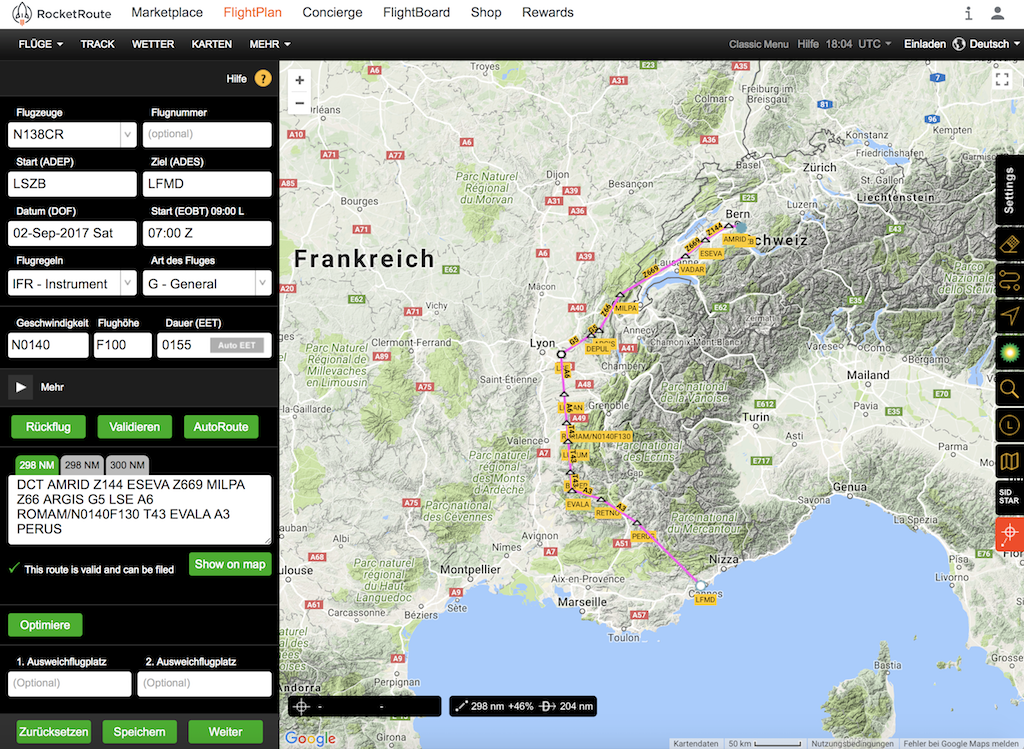
I filed an ICAO flightplan (FP) and got the acceptance confirmed by short message after one hour. The U.S. system is different and a lot simpler (one can plan an airways route from the chart alone, and usually one can fly it as filed). This is impossible in Europe and you need one of several online tools. Eurocontrol runs a database which contains all this and all FPs are verified against this database before acceptance. Obviously there is no way to plan a definitive route with any means that doesn’t have access to the database. Your job #1 is to get an FP accepted. It doesn’t have to be exact since ATC will give you a series of direct-to’s (or, in busy airspace, vectors) anyway along most of the route, so the route finally flown will always differ from anything planned.
IFR flight plans are filed via the Eurocontrol system called IFPS (Integrated Flight Plan Processing System) which distributes the flight plan to all enroute units, plus departure and destination, in seconds. This makes it possible to file a flight plan and depart minutes later – as soon as the tower confirms they have received it.
The IFPS operating manual is a several hundred pages tome, that contains vastly more information than any pilot should ever need to know, but it looks like a useful reference. In the following text, the words Eurocontrol, CFMU and IFPS tend to get used interchangeably, and both refer to the computer is Brussells which validates and manages the IFR routes.
Because I had filed my flight plan with Rocket Route (www.rocketroute.com), the route was already confirmed by ATC in Brussels and so I got the same route confirmed I had filed. It was LSZB AMRID Z144 ESEVA Z669 MILPA Z66 ARGIS G5 LSE A6 ROMAM/N0140F130 T43 EVALA A3 PERUS LFMD. Bern to Cannes direct would be a distance of 204 NM. So the confirmed route was 46% longer, 298 NM.
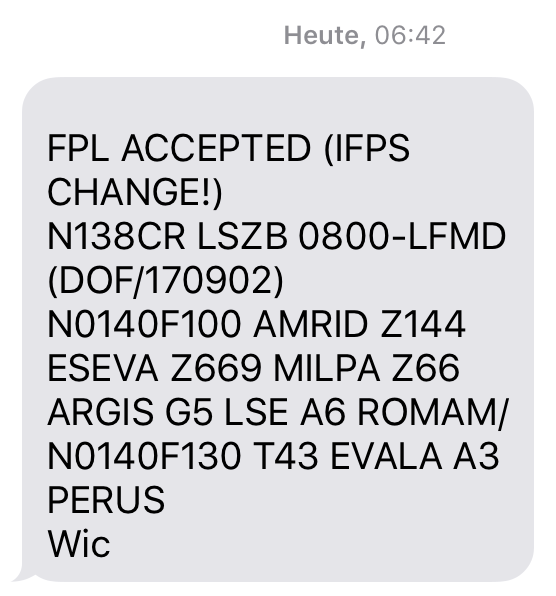
Flight plan confirmed!
I copied the route in my GARMIN Pilot App on the iPad. With GARMIN Connext you can transfer the flight plan in the GTN650 and your mobile touchscreen virtually becomes an extra digital control/display in the cockpit.
After filing the flight plan Conny, my wife, and Charly our dog drove to the airport. But before we arrived at the airport, I got a message on my mobile phone, that we got a slot. Slots are departure delays generated by the Eurocontrol computer. Some of the flight plan filing services offer a „premium“ option where slot notifications are sent by email or SMS, otherwise the airport tower should tell you when you are about to depart. Slots are rare on some routes and common on others. They are little more than a CFMU software artefact and are often cancelled (or substantially reduced in their delay) within the hour before departure. This means you have to be sitting in the aircraft and ready to go at the original EOBT. I have seen 2hr delays reduced to 10 minutes; the process is so haphazard that the only meaningful strategy is to remain ready to go as filed, and accept whatever delay you get.
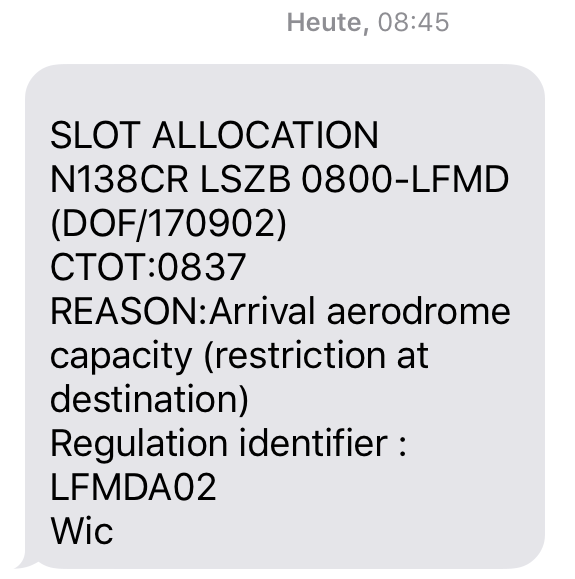
First slot at 0645 UTC
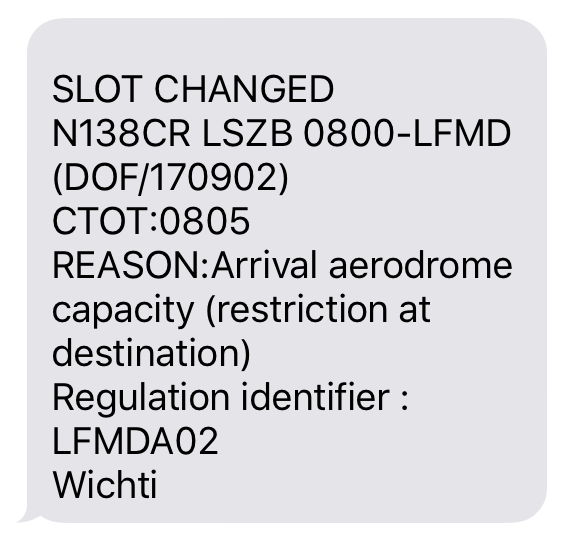
Next slot at o740 UTC with a CTOT time of 0805 UTC
I have slots on about 40% of my IFR flights. It can happen, that they delay the flight by an hour and force a hurried re-route because the originally planned airport would be closed. Then, the slot disappears so you could have departed at the original time and on the original plan. Sometimes it’s making you crazy! Time to spare, go by air!
We had planned our takeoff at 0800 UTC, but the slot gave us a CTOT (Calculated Takeoff Time) of 0837 UTC. Air traffic controllers must depart any flights that have received a CTOT within a tolerance window of -5/+10 minutes. If a flight is ready to depart before its CTOT, ATC must either have the aircraft wait on its parking position, or some other place at the airport. At many airports, airliners cannot be allowed to wait at the gate, because other arriving aircraft need to use the gate. It is then up to ATC to figure out what to do with the CTOT restricted flights until they can depart. If a flight misses its CTOT, ATC is not allowed to issue a takeoff clearance. A new CTOT must be requested through IFPS, and the flight will potentially be delayed.
With my CTOT of 0837 UTC we theoretically had more time, but because you can suddenly receive an earlier CTOT, you have to hurry to make the plane ready and stay with the plane. Because it was raining, I left wife and dog in the FBO, went through the security check and went out to prepare and refuel the plane. Even at my home base, I have to pass every time the security check with X-ray etc. when I go out flying! And when you go a dozen time a day to your aircraft and everyone knows you at the airport personally, you have to pass the security check. That’s life in General Aviation in Switzerland since many years and one of the results of 9/11!
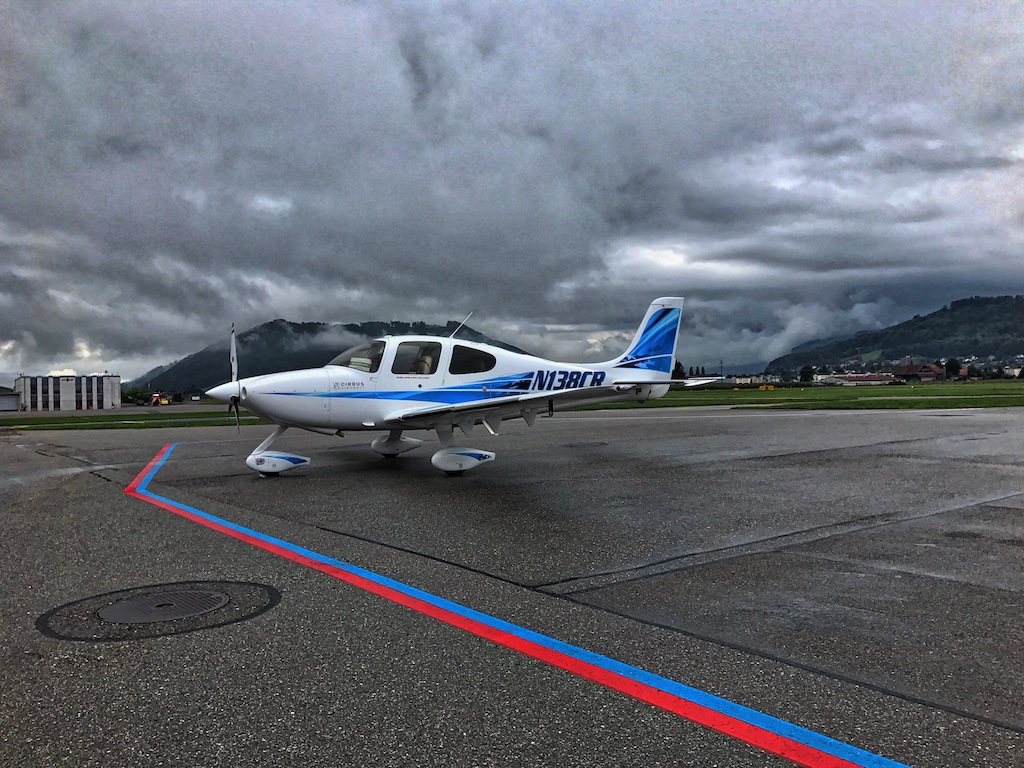
I prepared everything, made the outside check, tied the luggage in the Cirrus and was ready. Only refueling seemed to be difficult. I had called the fuel truck, when I arrived at the airport, but the fuelman was busy elsewhere. At 0740 I got a new CTOT at 0805 and I still had no fuel. Because passengers are not allowed to come to the plane without company after security check, I had to pick up my wife at the security checkpoint and this cost even more time. Finally the AVGAS truck arrived, I topped up the tanks and we boarded the plane.
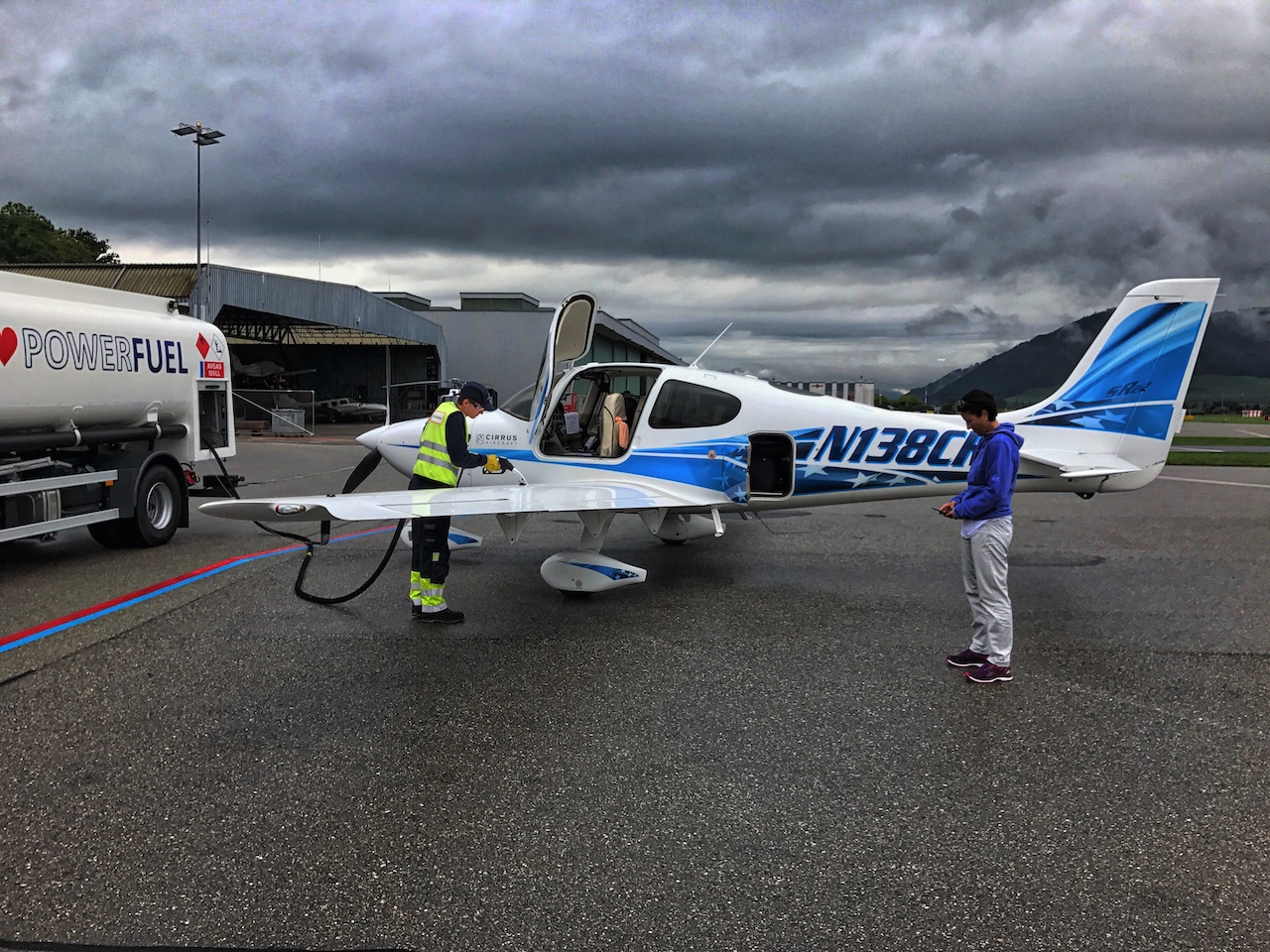
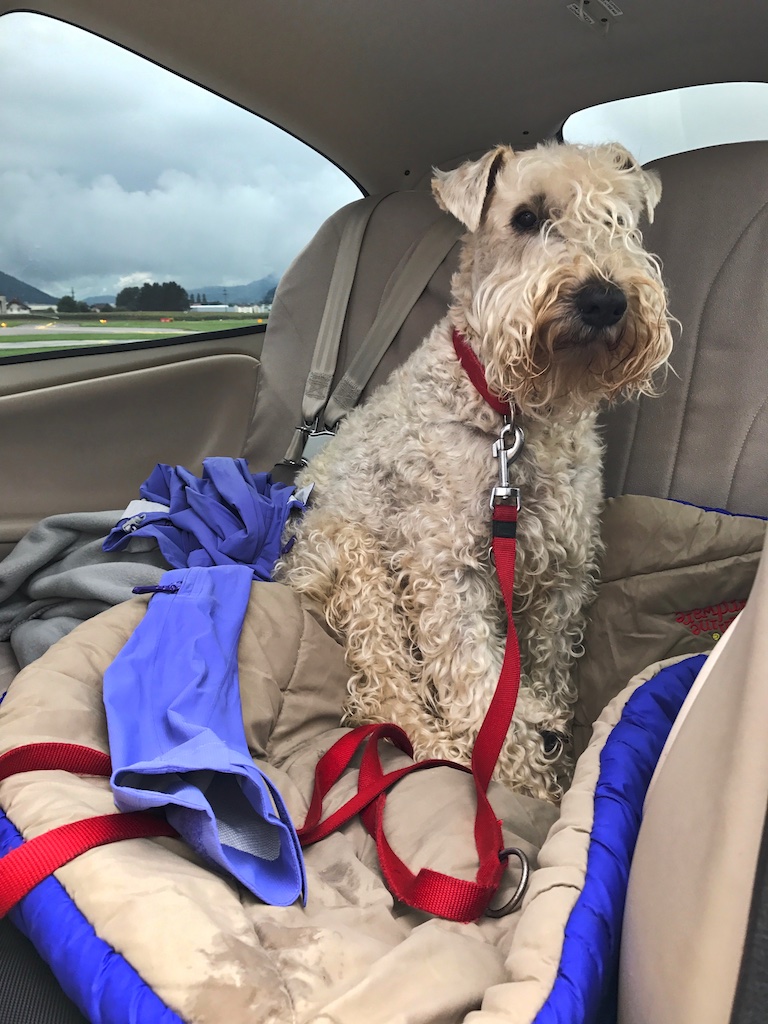
If you are flying IFR in Europe, you need to ask for a startup clearance. After listening to the ATIS I contacted tower with the request for startup and clearance. I got the following clearance: “Runway in use 14, QNH 1019, cleared to Cannes with a AMRID 2S departure, J72 transition, cleared initially to FL 080 and Squawk 2772”. The ATIS for Bern at 0800 UTC was “Information K, runway in use 14, ILS 14, wind variable at 2 knots, visibility 10 kilometers, temperature 12, dew point 11, clouds few at 2’100 ft, scattered 2’700 ft, broken 5’000 ft and the QNH 1019 hPa“
Starting the engine and doing all the checks went smooth and fast, because the flightplan was already stored in the GTN650. We were ordered to holding point A 14, where I made the runup, takeoff and departure briefing and after a backtrack we departed at 0808 UTC and were soon in solid IMC.
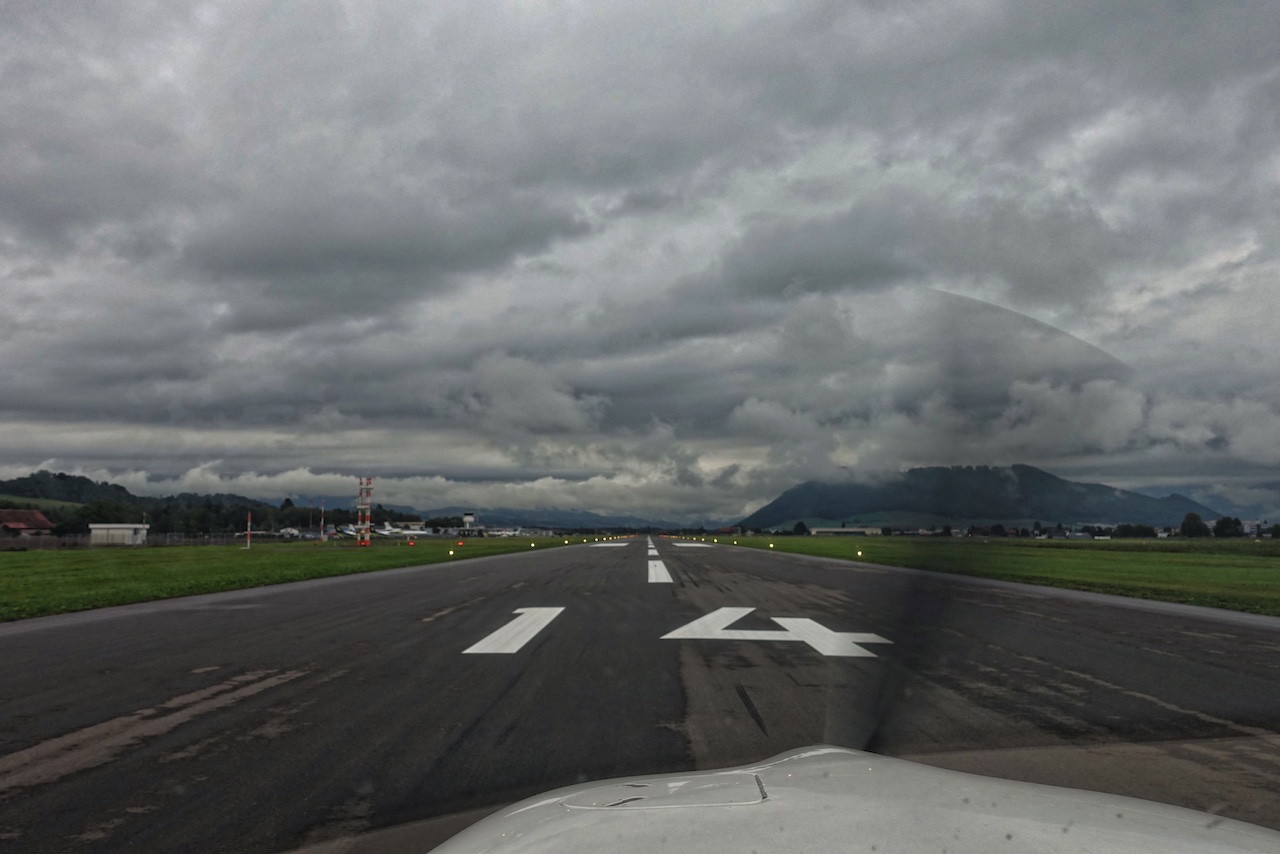
Bern Tower passed me to Bern Departure and I got a short cut to AMRID after reaching 6’000 ft. Before reaching AMRID, I was passed to Swiss Radar on 128.5 MHz. They cleared me first to FL 090 and then to FL 110. I flew more or less on the filed route, was from time to time in clouds, where I took some ice, but the anti-ice system of the Cirrus worked well. Next frequency was Geneva Departure on 119.525 MHz. They cleared for FL 130 to leave the clouds and the ice below me. Over and over again we had to ask for deviations because many buildups were in our way.
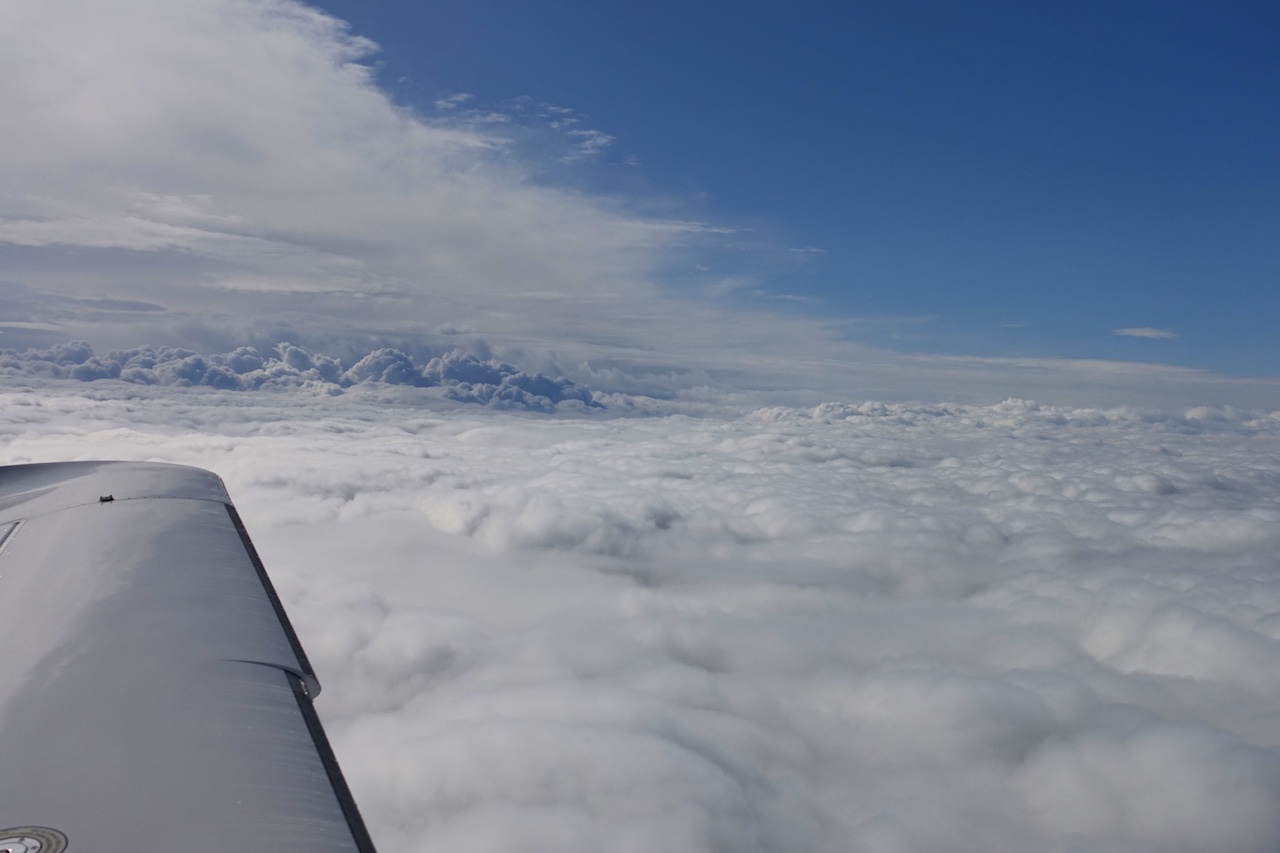

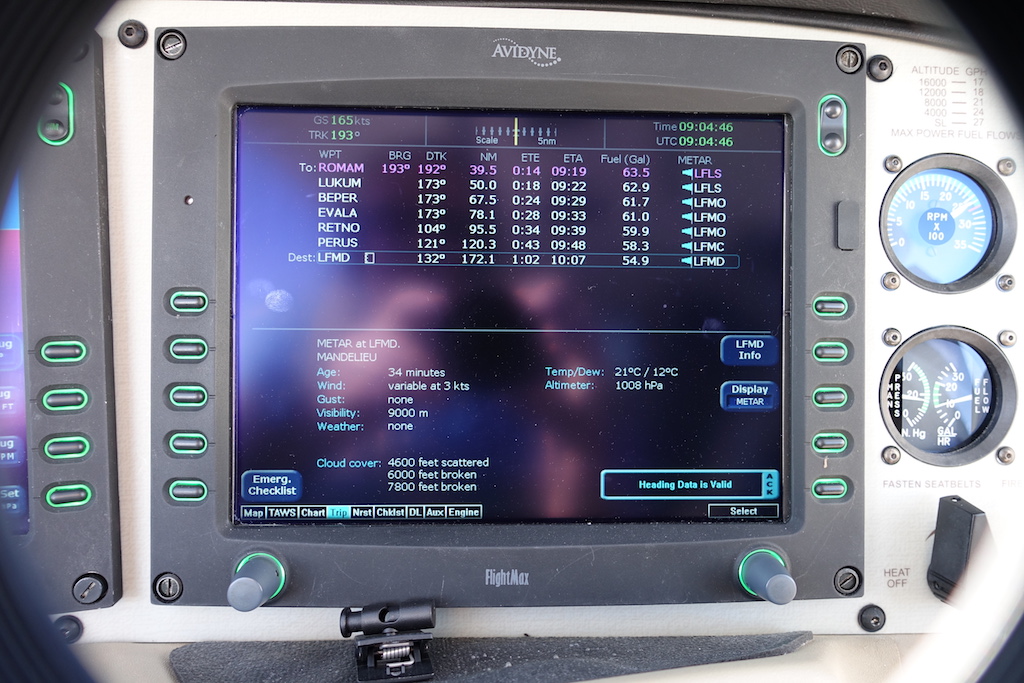
The satellite datalink shows the weather in Cannes
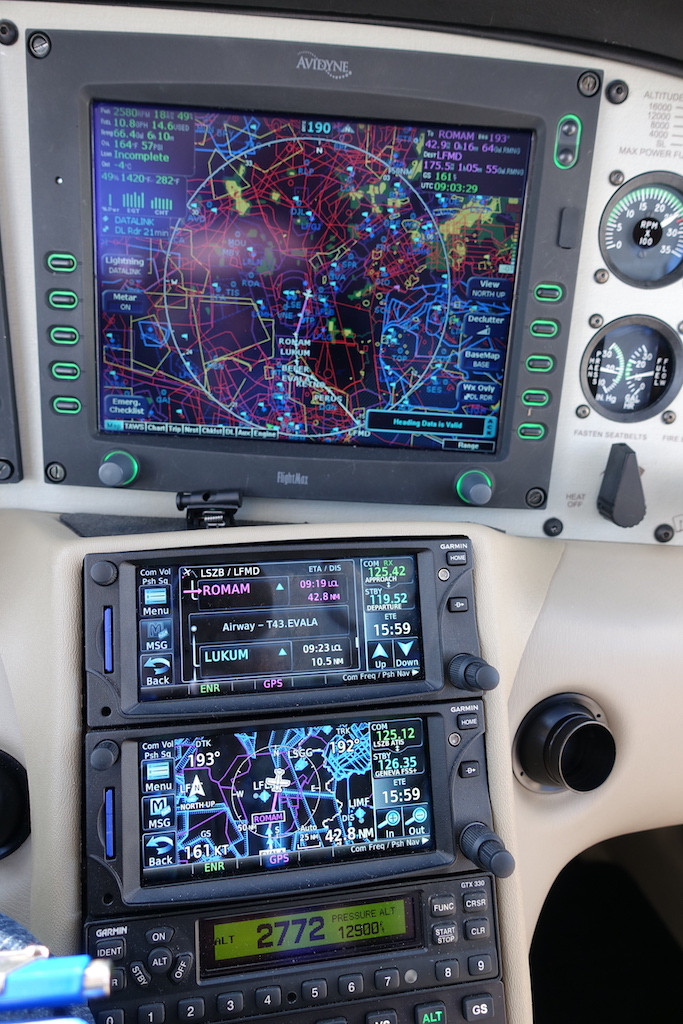
You see on the MFD, that we avoided the precipitation
The „weeping wing“ system-that deices the wings, horizontal stabilizer and propeller is not certified for known icing, but is designed to allow pilots to escape from icing conditions. The fluid reservoir holds about an hour’s worth of protection.
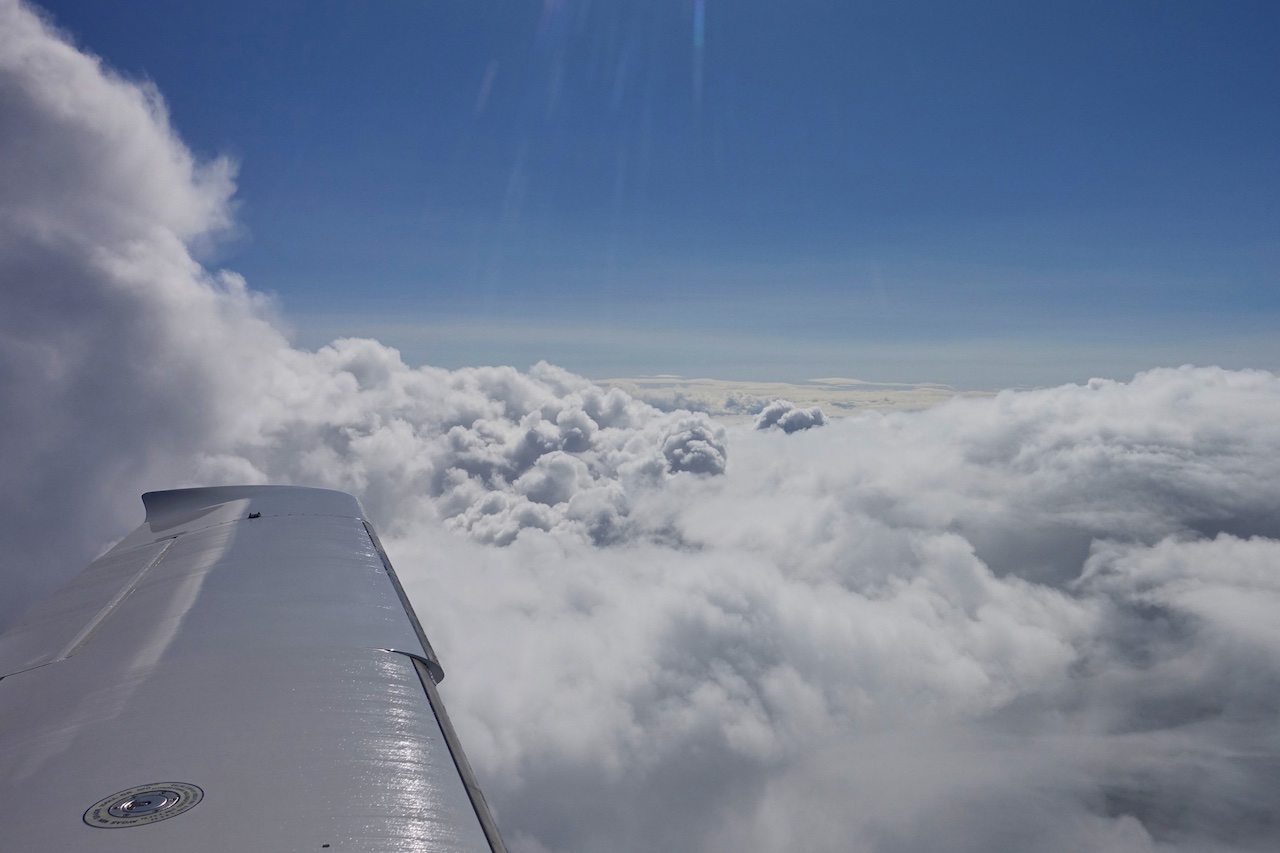
Here you see, why the system is called the „wheeping wing“
Lyon Approach on 125.425 MHz gave us a little short cut on our way to the south. With the Mistral we had a good tailwind of sometimes 40 Knots. The Mistral is a strong, cold, northwesterly wind that blows from the region of Geneva to southern France into the Gulf of Lyon in the northern Mediterranean, with sustained winds often exceeding 40 Knots, sometimes reaching 100 Knots. It is most common in the winter and spring, and strongest in the transition between the two seasons. Periods of the wind exceeding 20 Knots for more than sixty-five hours have been reported. It has a major influence all along the Mediterranean coast of France, and often causes sudden storms in the Mediterranean between Corsica and the Balearic Islands.
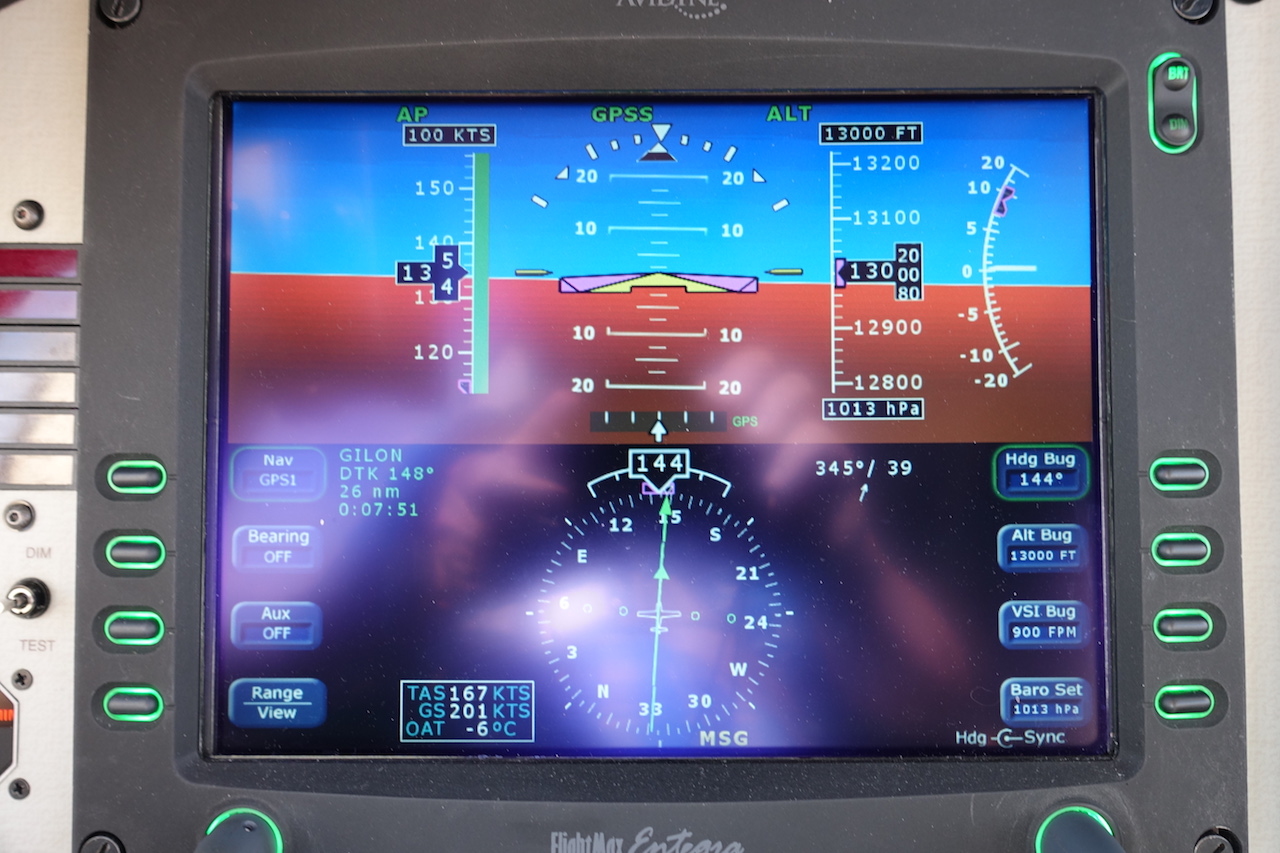
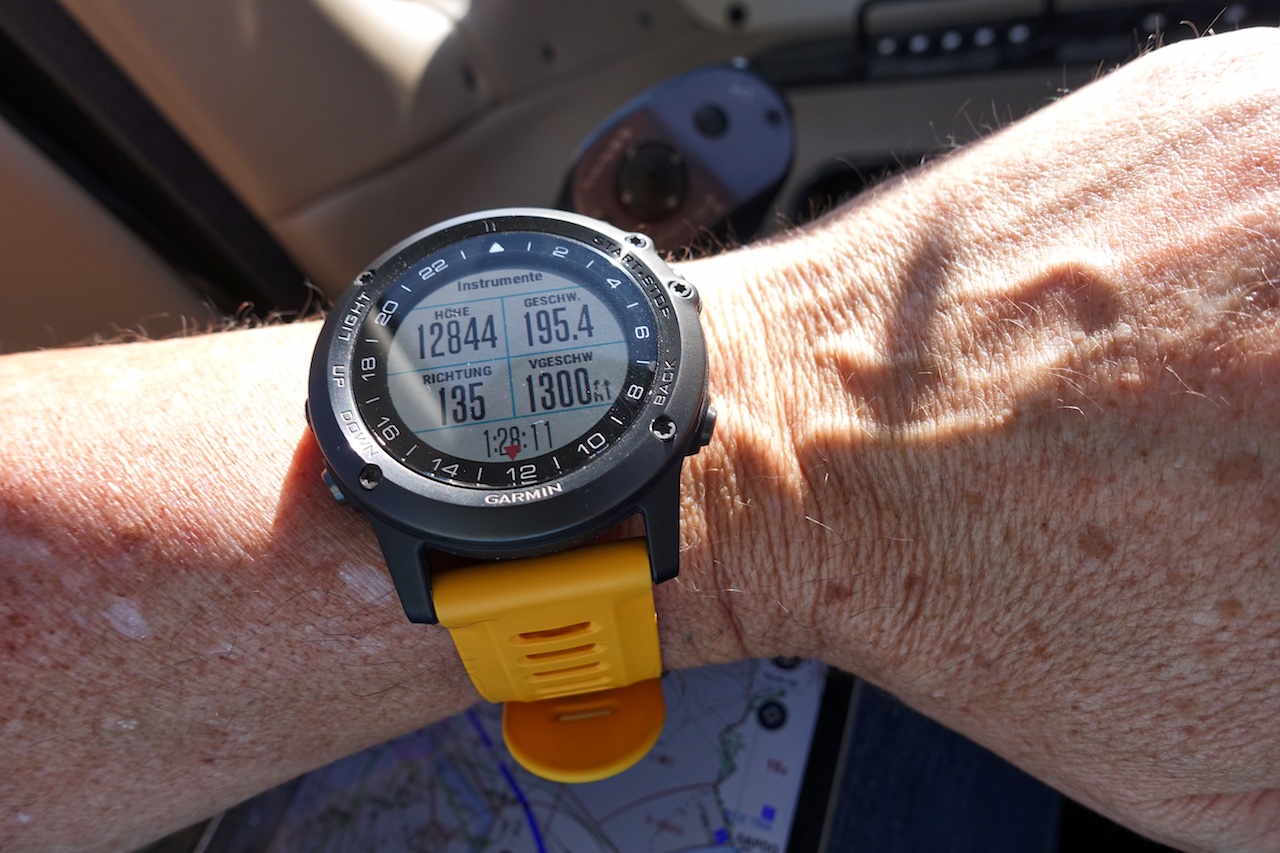
From Lyon Approach we were passed to Marseille ACC on 123.9 MHz and there we got a new route to the south west – away from our destination – to the Montelimar (MTL) VOR. In this region it was finally possible to see the ground while the clouds broke up. Marseille ACC passed us to Marseille Control on 127.905.There we initially got a heading even further to the south west, then to the south on 180 degrees and finally back on our original route to RETNO.
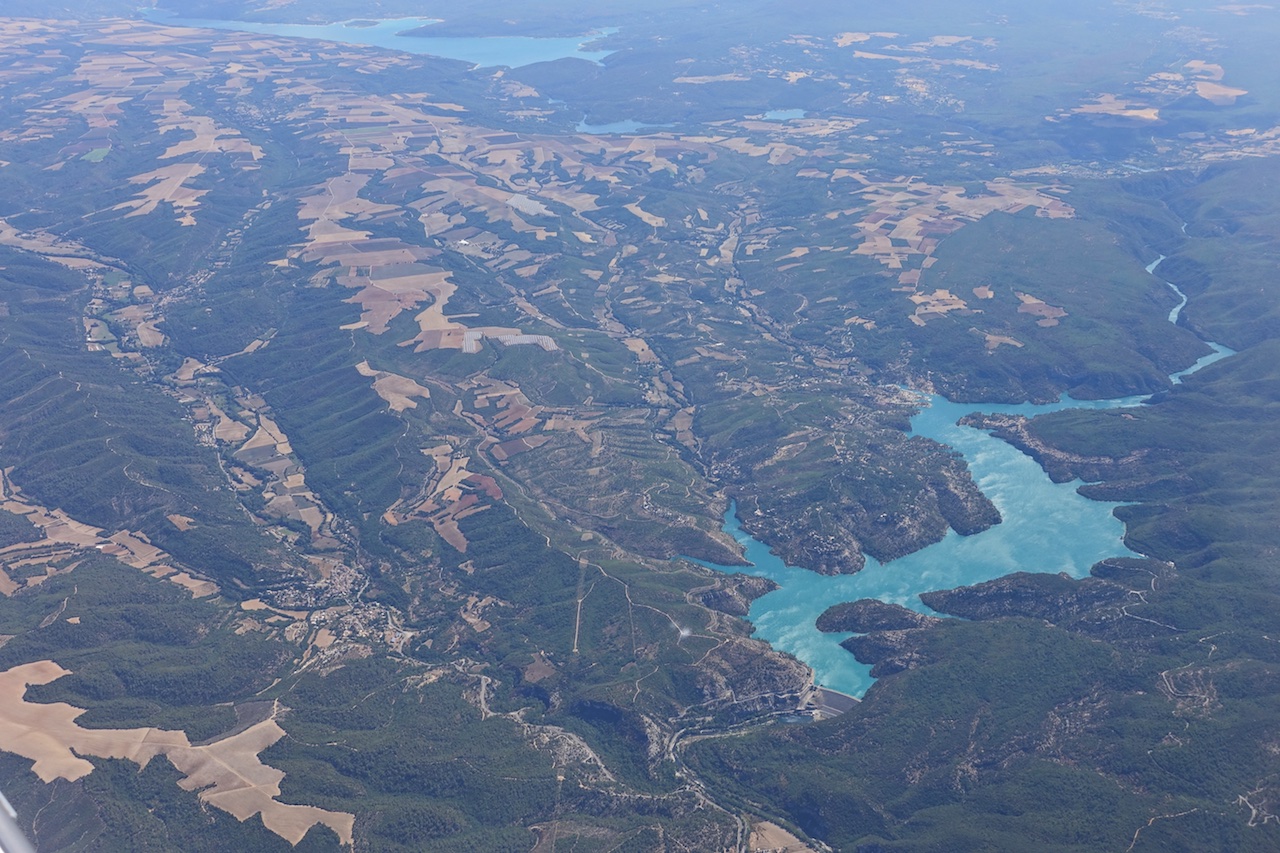
The Lac de St. Croix in the background
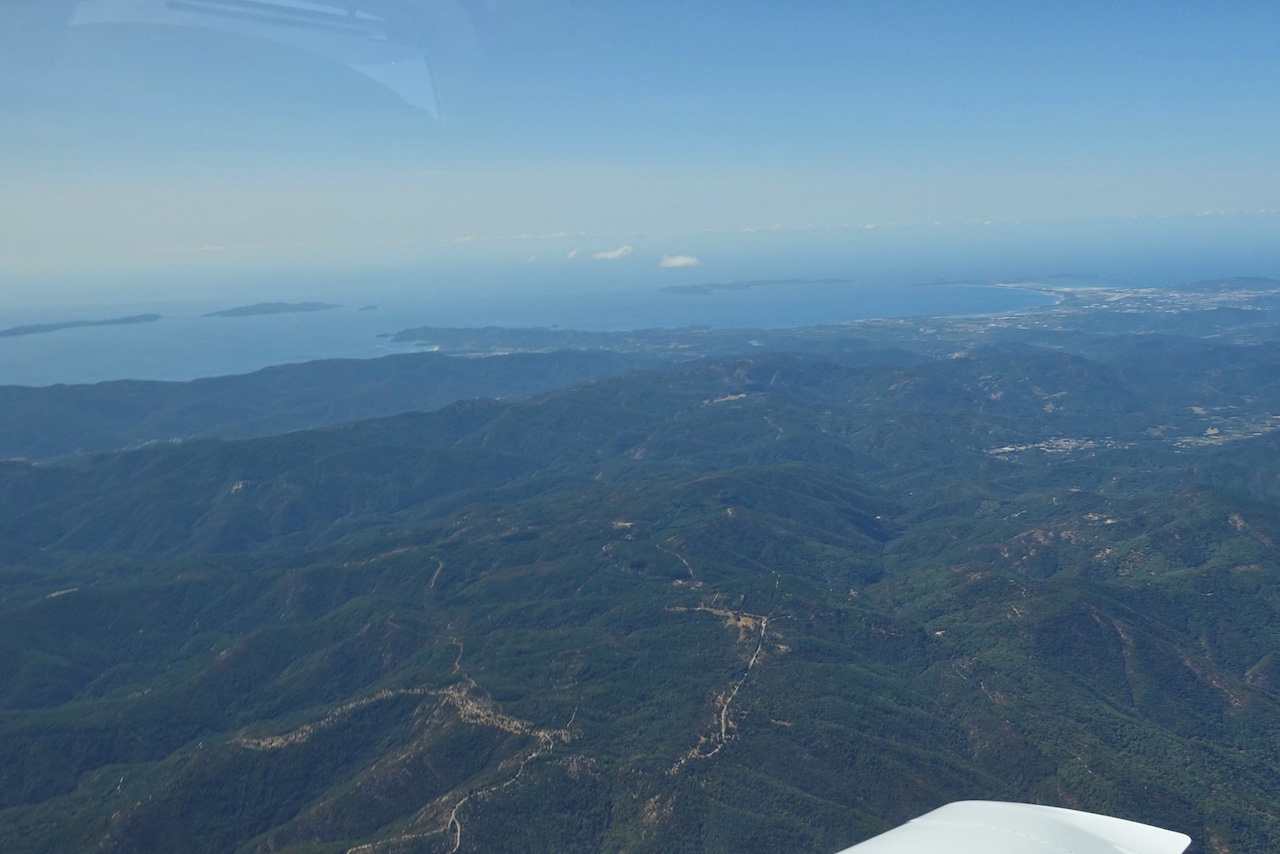
Hyères with the Îlles d’Hyères in the background
Because there were many gliders in the area, we once again got vectors. First 25 degrees to the right, then another 15 degrees to the right and once again 15 degrees. Finally Marseille passed us to Nice Approach on 134.475 MHz and we could start our descent. First to FL 100, then to FL 80. Because we flew with a groundspeed of more than 200 knots, we were too fast and over NEKIP they sent us in a holding, because we were only number 4.
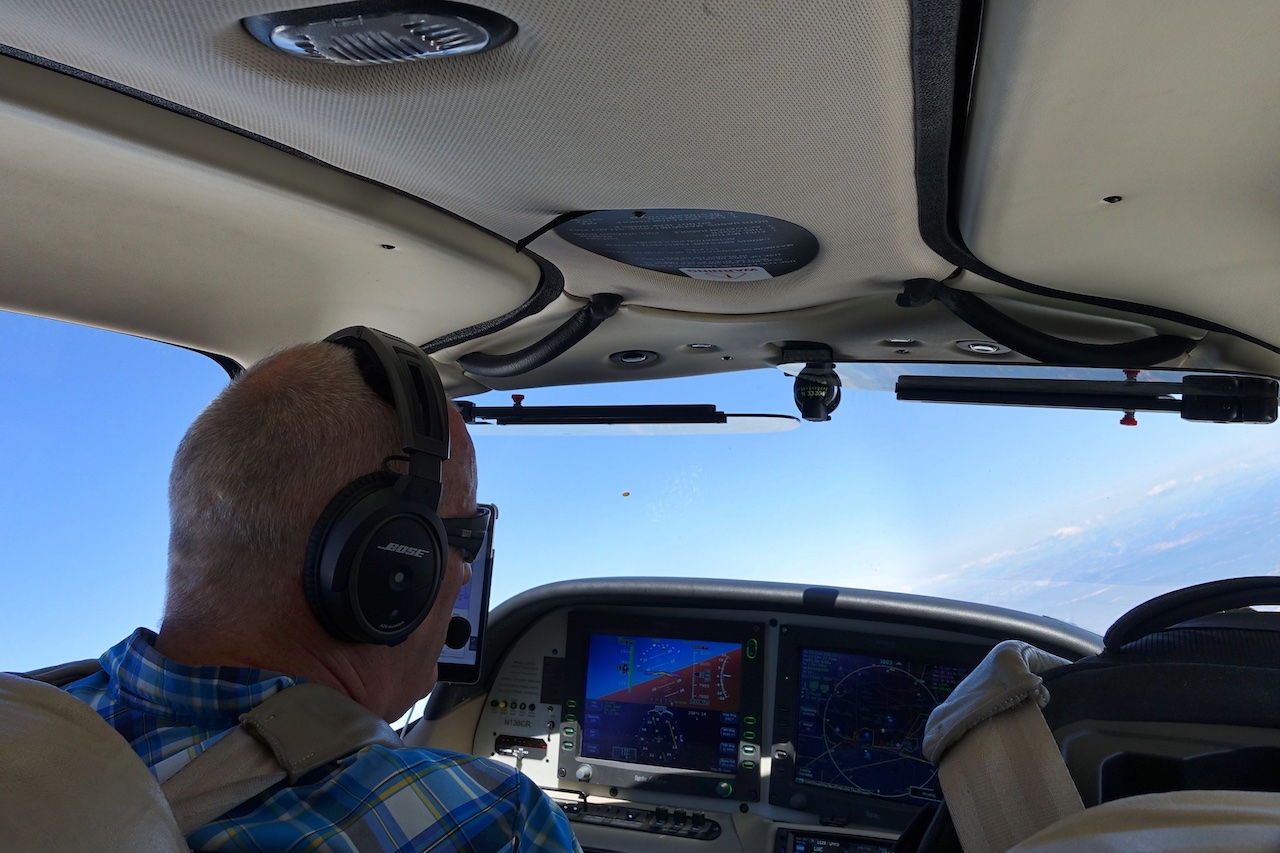
After the holding we were cleared for a further descend to 5’000 ft. Nice Approach on 120.650 finally sent us down to 2’000 ft over the deep blue Mediterranean water, where we were below the traffic approaching the airport of Nice LFMN. Nice had a lot of traffic today and the controllers were very busy and stressed. For a Cirrus driver it’s not so funny, when you listen to the controller talking with the pilot of a Turbo-Firecat waterbomber. He told him to look out for “un petit avion SR22” (a small SR22 aircraft). 😡
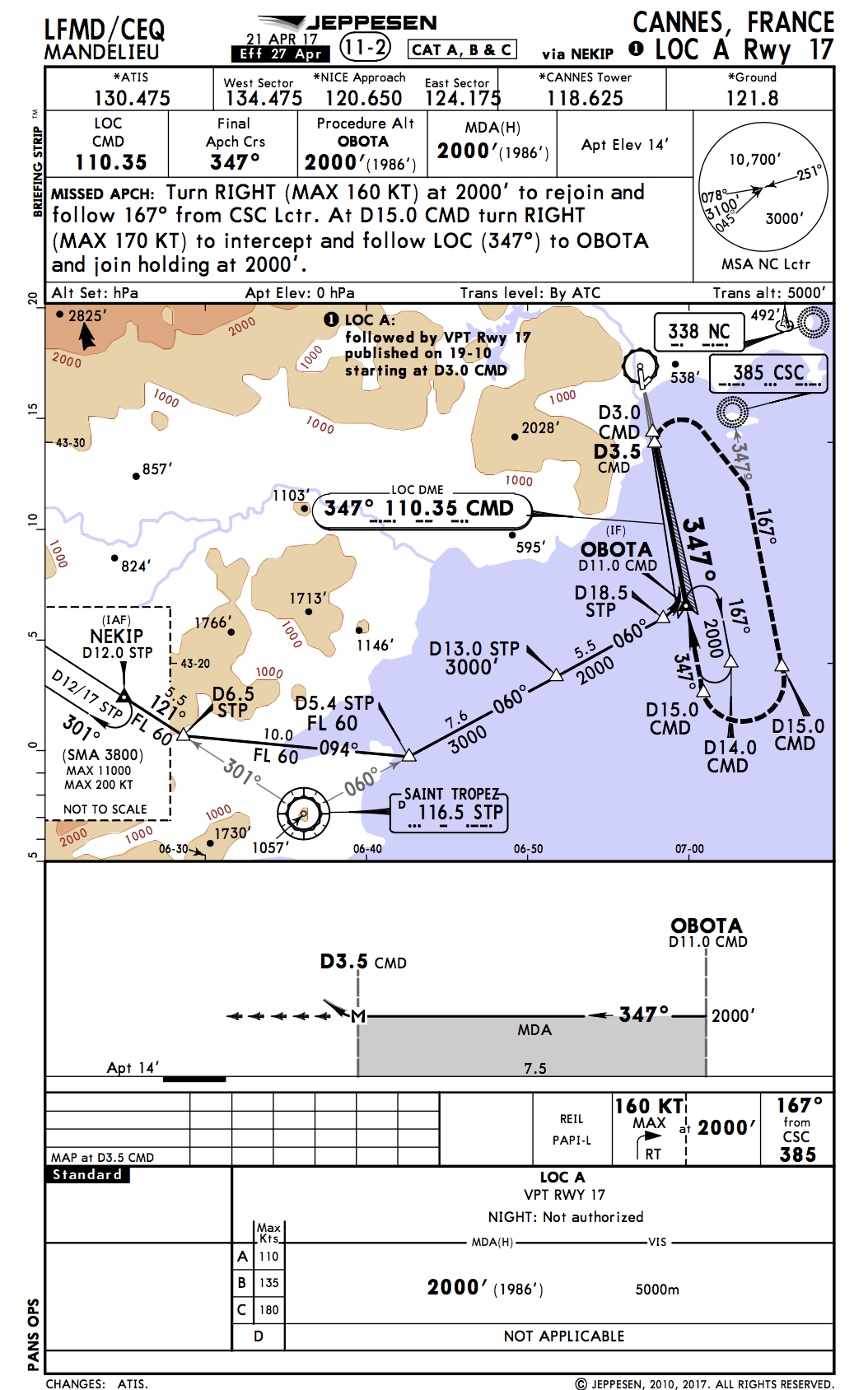
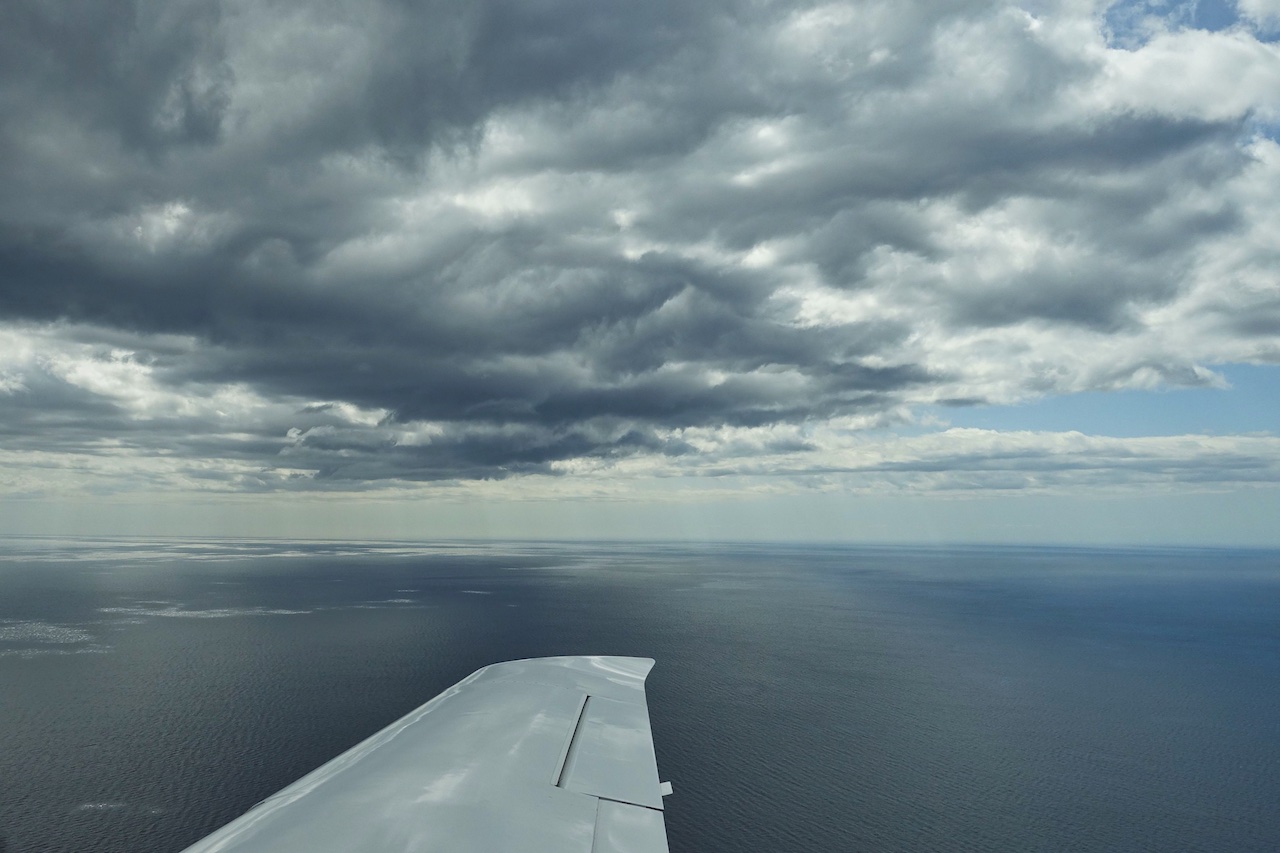
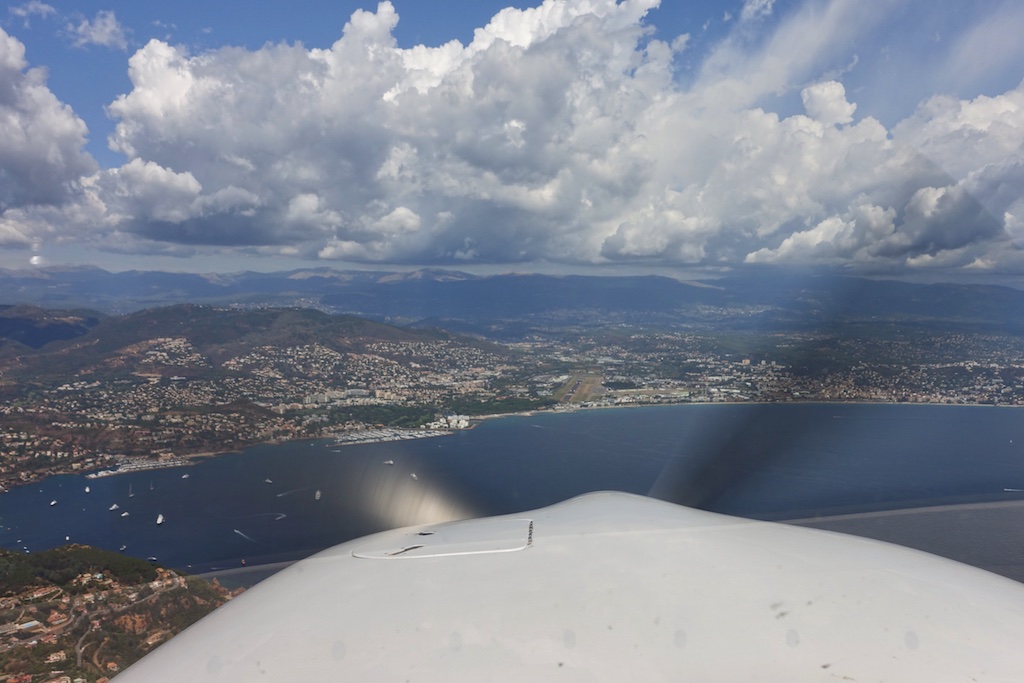
We nearly overshot the Loc A approach of Cannes, when we were finally cleared for the approach and intercepted the localizer for runway 17 at 2’000 ft. You approach the runway from the south, but at DME 3.0 you must turn right to the waypoint LUXUS and then to PIBON before you can make the base turn for a long final for runway 17. The landing was smooth with only 10 Knots of wind.
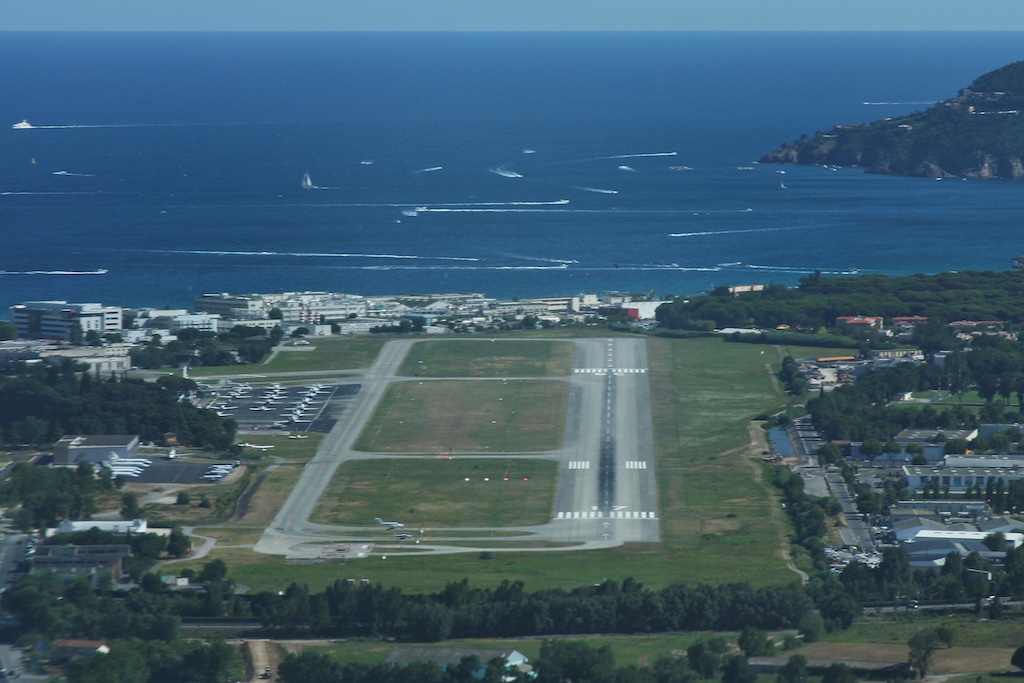
Leaving the runway and contacting tower was the next frequency change. I always try to refuel directly after landing when I am flying to Cannes, to avoid any surprises with waiting time at the fuel pump when flying back home. To get to the fuel pump, you have to taxi to the north and take the yellow line 7 to the fuel pump. Cannes has two AVGAS pumps, number 1 for those of you with a BP card and number 2 for all other major credit cards. We refueled 131 liters (34.6 Gal) and were charged € 272.31 ($ 323). This makes $ 9.34/Gal and means twice as much as average U.S. AVGAS.
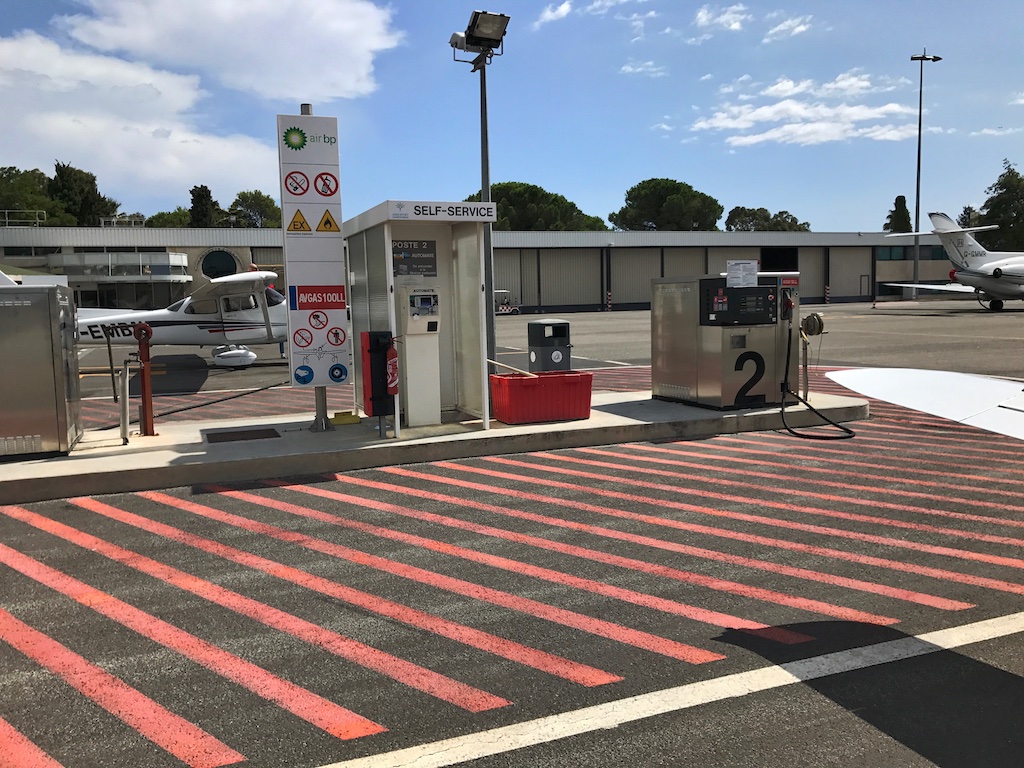
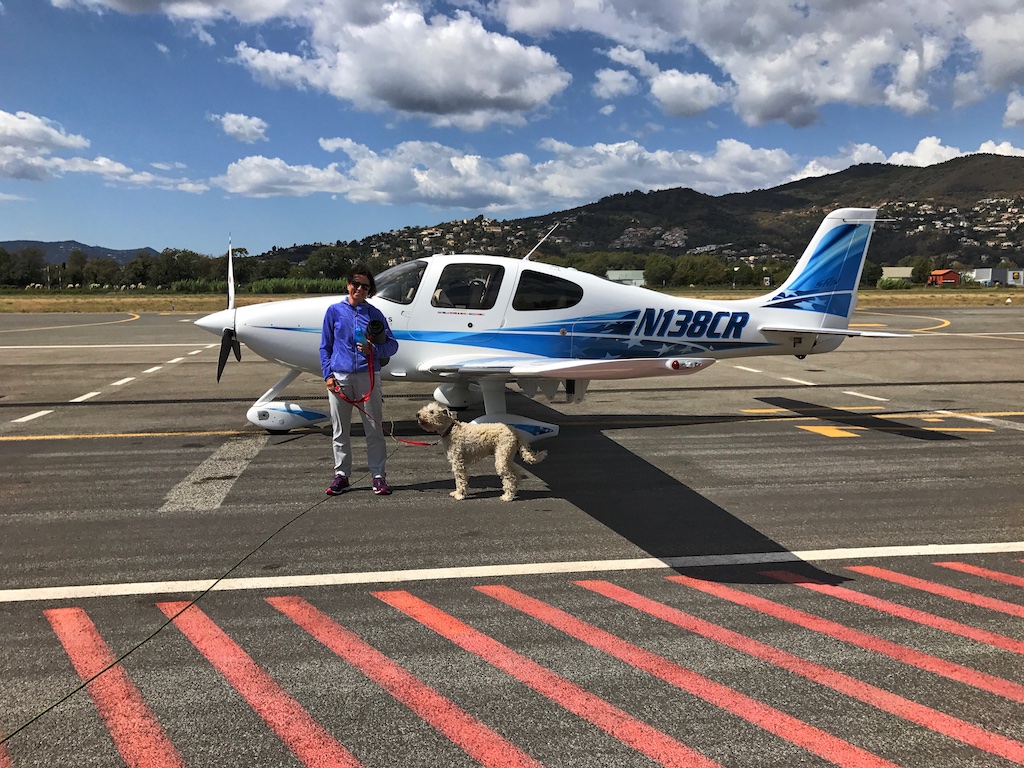
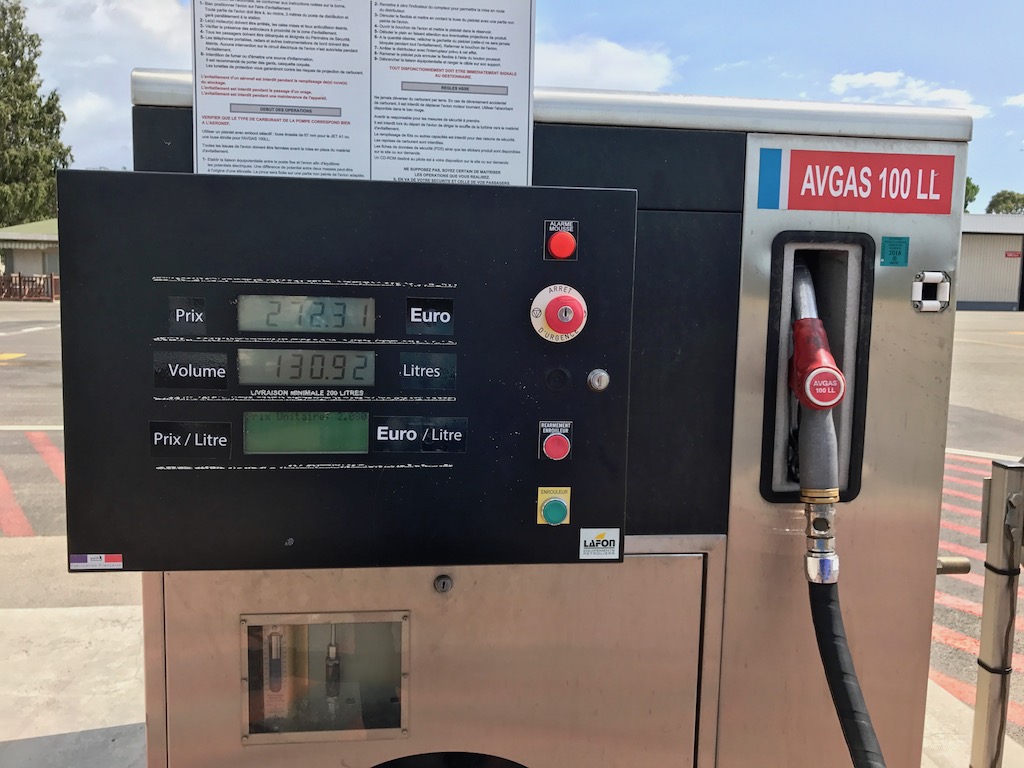
Dear U.S. friends: AVGAS prices in Cannes are average in Europe!
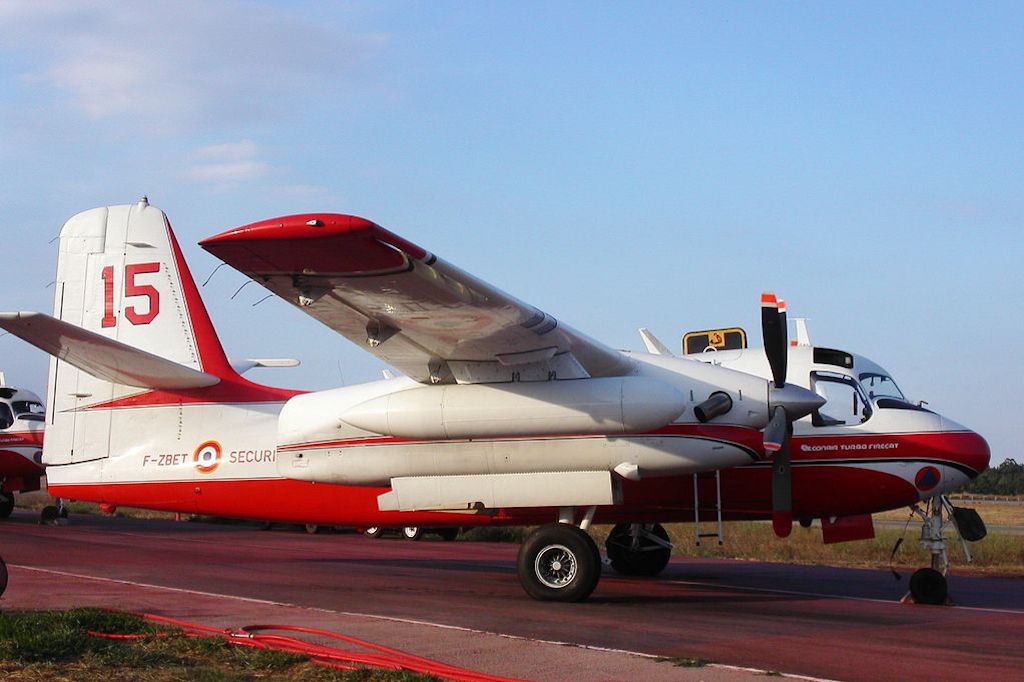
The mentioned Turbo Tracker
After refueling we asked for a parking position and taxied to the grass parking along taxiway Y. We were finally there, offloaded our baggage and went to the french border police in the main building, where you have to show an ID and fill out a “Pax Manifest”. Last time, police asked me to fill it out at home and send it by e-mail. I have searched the internet for half an hour to find this form, but no success. Today they told me, that you have to send an e-mail to operations-acm@cote-azur-aeroport.fr and they send you the form. But’t worry if you don’t do it! You can still fill it out after arrival at the police desk.
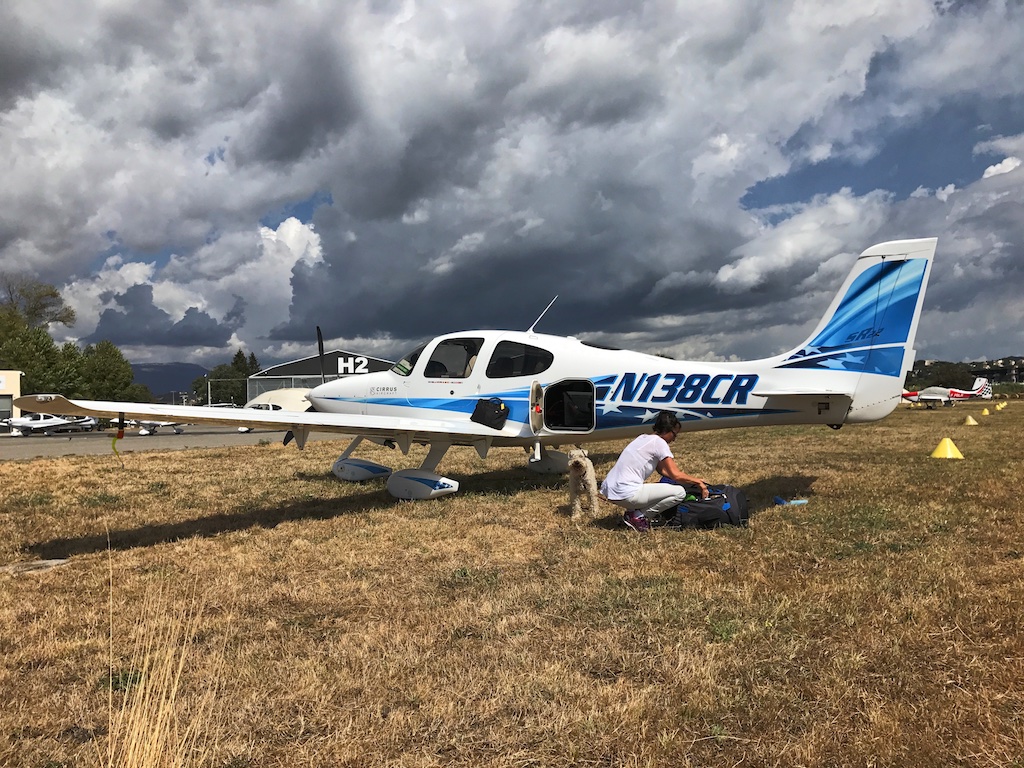
At the French Riviera you always find many business jets
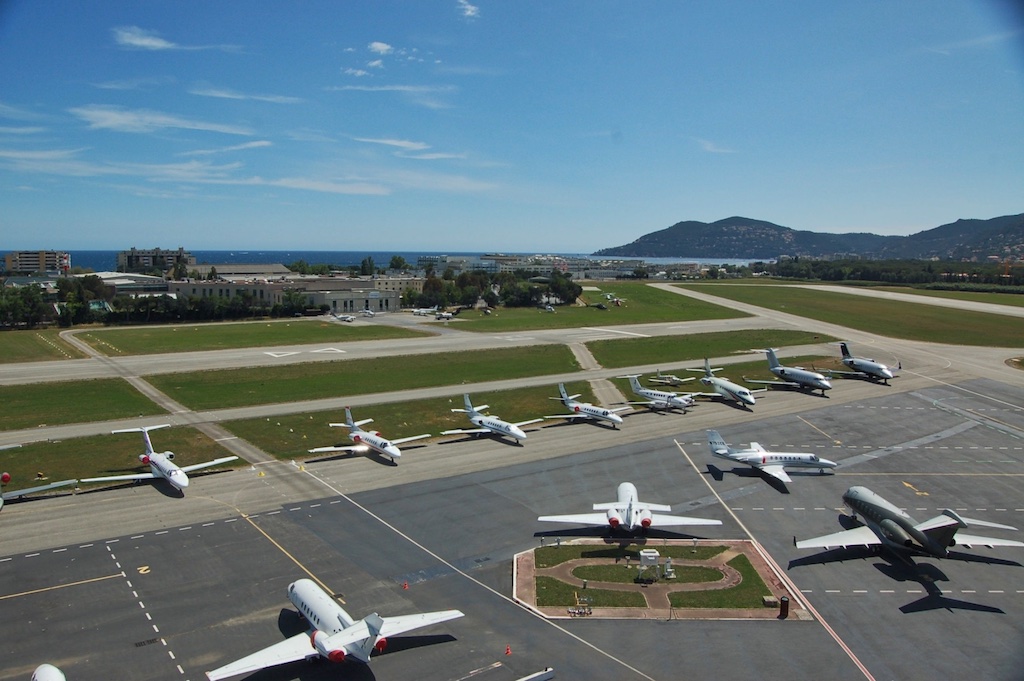
And at the end:
- Direct route Bern – Cannes is a bare 204 NM
- Planned and confirmed route was 298 NM (46% more)
- Flown route 382 NM (87% more)
- We had every weather you can safely fly with a non turbo SR22
- And finally a perfect training flight
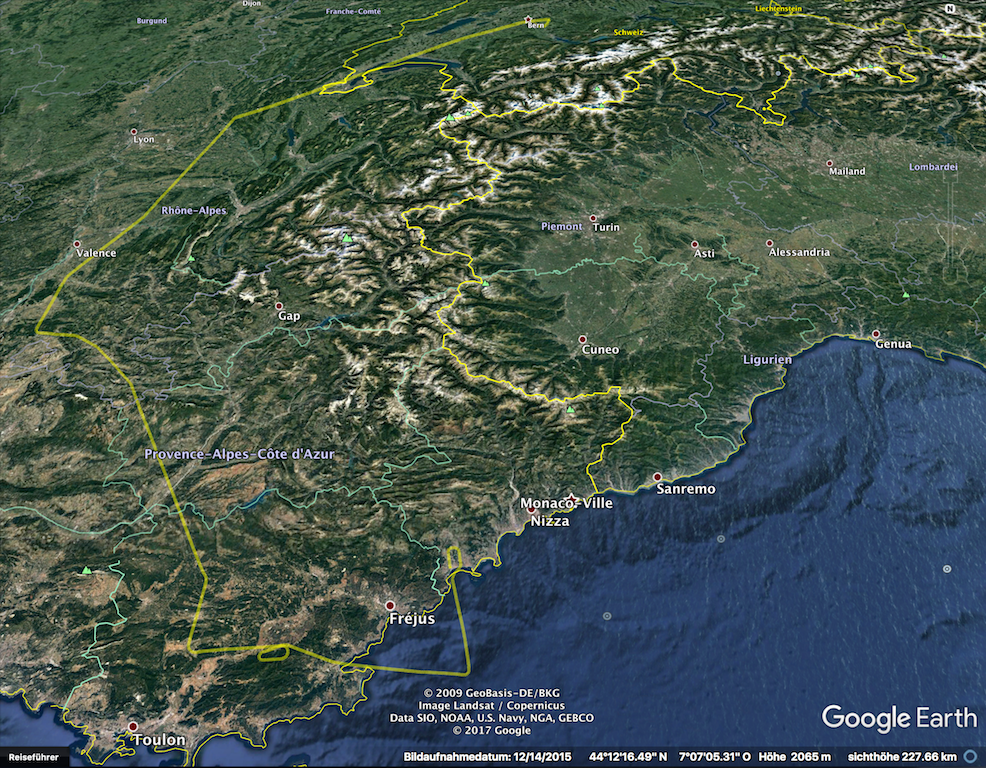
And finally in the hotel
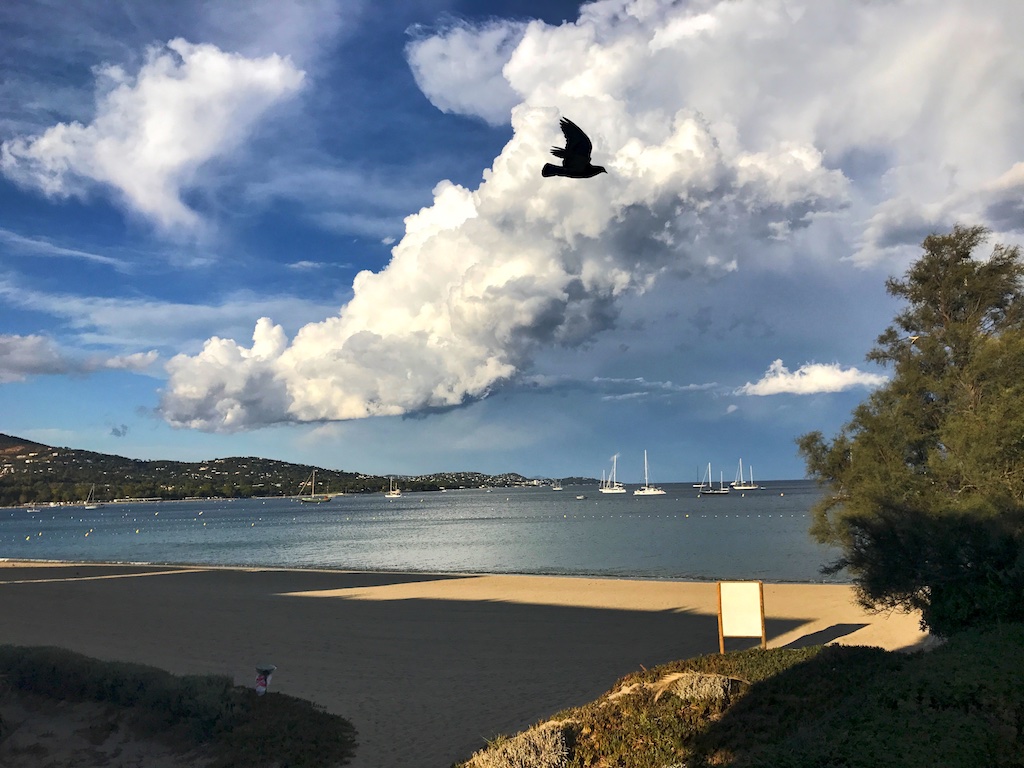

Salü Conny und Roger
sehr interessanter Bericht. Auch die Bilder vom Cockpit sind super.
Geniesst euren Aufenthalt.
Gruss Andi
Thanks for the story. I’m training for IR Right now. Regards